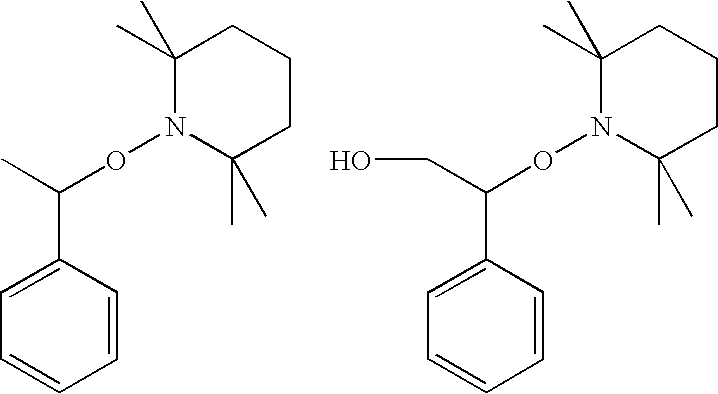Curable composition
a technology of composition and cure, which is applied in the field of cureable composition and cured product, can solve the problems of insufficient mechanical properties and deterioration in compatibility, and achieve the effects of improving mechanical properties, excellent curability, and oil resistan
- Summary
- Abstract
- Description
- Claims
- Application Information
AI Technical Summary
Benefits of technology
Problems solved by technology
Method used
Image
Examples
production example 1
Synthesis of poly(n-butyl acrylate / ethyl acrylate / 2-methoxyethyl acrylate) Having Acryloyl Groups at Both Termini
[0280]4.34 g (30.3 mmol) of copper(I) bromide and 74.3 mL acetonitrile were introduced into a 1-L flask and stirred under heating at 70° C. for 20 minutes in a nitrogen stream. 18.1 g (50.3 mmol) of diethyl 2,5-dibromoadipate, 216.6 mL (1.51 mol) of n-butyl acrylate, 301.2 mL (2.78 mol) of ethyl acrylate, and 225.4 mL (1.75 mol) of 2-methoxyethyl acrylate were added, and the mixture was stirred under heating at 80° C. for 20 minutes. 0.21 mL (1.00 mmol) of triamine was added to initiate the reaction. Additional triamine was added properly, and the mixture was stirred under heating at 80° C., and when the polymerization reaction rate exceeded 95%, the polymerization was finished. 300 g of this polymer was dissolved in N,N-dimethylacetamide (300 mL), and 7.4 g of potassium acrylate was added thereto, and the mixture was stirred under heating at 70° C. for 3 hours in a nitro...
production example 2
Synthesis of poly(n-butyl acrylate / ethyl acrylate / 2-methoxyethyl acrylate) Having Acryloyl Groups at Both Termini
[0281]4.18 g (2.91 mmol) of cuprous bromide as a catalyst and 95.5 mL acetonitrile were charged and stirred under heating at 70° C. for 20 minutes in a nitrogen stream. 1.75 g (4.86 mmol) of diethyl 2,5-dibromoadipate, 278.5 mL (1.92 mol) of n-butyl acrylate, 387.2 mL (3.57 mol) of ethyl acrylate, 289.8 mL (2.25 mol) of 2-methoxyethyl acrylate were added thereto, and the mixture was stirred under heating at 80° C. for 20 minutes. 0.17 mL (0.85 mmol) of triamine was added to initiate the reaction. Additional triamine was added properly, and the mixture was stirred under heating at 80° C., and when the polymerization reaction rate exceeded 95%, the polymerization was finished.
[0282]400 g of this polymer was dissolved in N,N-dimethylacetamide (400 mL), and 10.7 g of potassium acrylate was added thereto, and the mixture was stirred under heating at 70° C. for 6 hours in a nit...
production example 3
Synthesis of an acryloyl group-terminated n-butyl acrylate polymer
[0284]3.36 g (23.5 mmol) of copper(I) bromide and 89.4 mL of acetonitrile were introduced into a 1-L flask and stirred under heating at 70° C. for 20 minutes in a nitrogen stream. 14.0 g (38.9 mmol) of diethyl 2,5-dibromoadipate and 894 mL (6.24 mmol) of n-butyl acrylate were added, and the mixture was stirred under heating at 80° C. for 20 minutes. 0.16 mL (0.77 mmol) of triamine was added to initiate the reaction. Additional triamine was added properly, and the mixture was stirred under heating at 80° C., and when the polymerization reaction rate exceeded 95%, the polymerization was finished.
[0285]400 g of this polymer was dissolved in N,N-dimethylacetamide (400 mL), and 7.4 g of potassium acrylate was added thereto, and the mixture was stirred under heating at 70° C. for 3 hours in a nitrogen atmosphere, to give an acryloyl group-terminated n-butyl acrylate polymer ([3]) mixture. The N,N-dimethylacetamide in this m...
PUM
| Property | Measurement | Unit |
|---|---|---|
| Temperature | aaaaa | aaaaa |
| Time | aaaaa | aaaaa |
| Composition | aaaaa | aaaaa |
Abstract
Description
Claims
Application Information
 Login to View More
Login to View More - R&D
- Intellectual Property
- Life Sciences
- Materials
- Tech Scout
- Unparalleled Data Quality
- Higher Quality Content
- 60% Fewer Hallucinations
Browse by: Latest US Patents, China's latest patents, Technical Efficacy Thesaurus, Application Domain, Technology Topic, Popular Technical Reports.
© 2025 PatSnap. All rights reserved.Legal|Privacy policy|Modern Slavery Act Transparency Statement|Sitemap|About US| Contact US: help@patsnap.com



